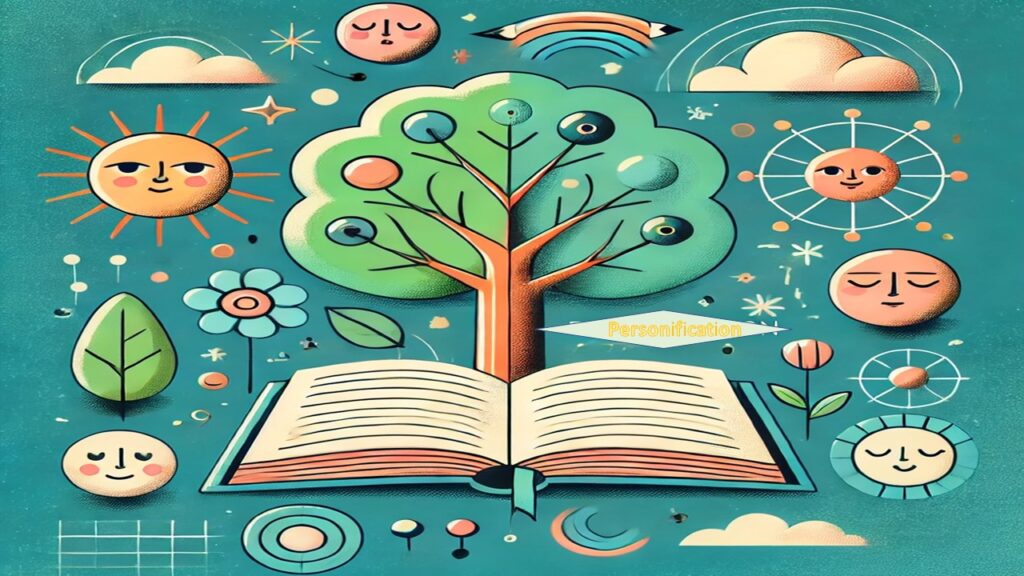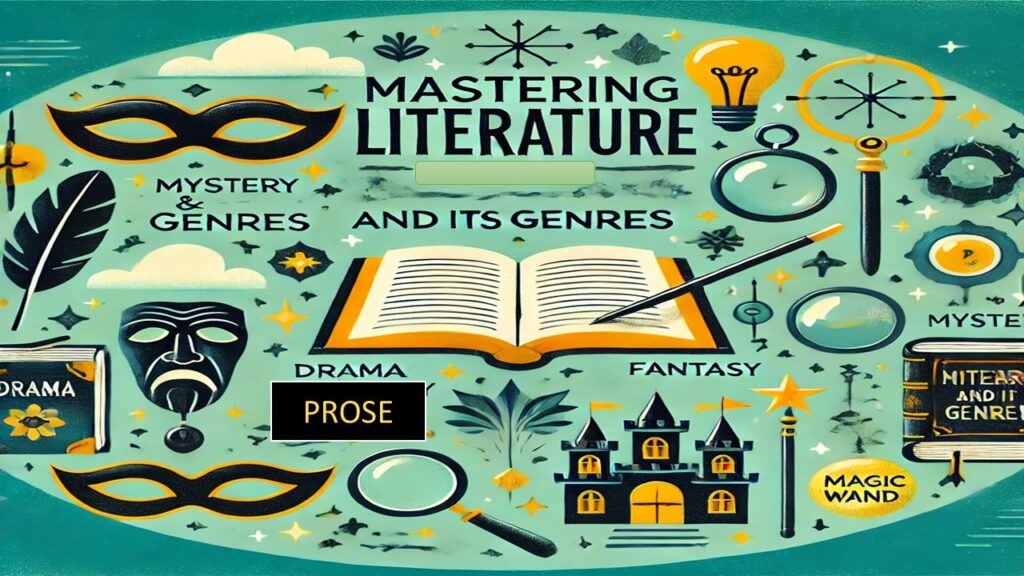What is a Metaphor?
A metaphor is an implied simile. This figure of speech directly compares two unlike items by stating that one thing is another. This comparison is not meant to be taken literally but is used to highlight the similarities between the two subjects.
-
Definition and Structure:
A metaphor involves stating that one thing is something else, suggesting a likeness between the two.
Example: “Time is a thief.”
“All the world’s a stage” – William Shakespeare
“Hope is the thing with feathers” – Emily Dickinson
-Implied Metaphor:
The comparison is implied rather than explicitly stated. For example, “He barked commands” implies that the person is being compared to a dog.
-Extended Metaphor:
This is a metaphor that extends over several lines or throughout an entire piece of writing. Example of an Extended Metaphor:
In Shakespeare’s “As You Like It,” the famous monologue begins with the line:
“All the world’s a stage,
And all the men and women merely players;
They have their exits and their entrances;
And one man in his time plays many parts.”
In this extended metaphor, Shakespeare compares life to a play and people to actors. He develops this metaphor over several lines, explaining how each person has roles they play at different stages of life, with “exits and entrances” symbolizing birth and death. This comparison runs through the entire passage, adding depth to the idea that life is transient and that we each perform different “roles” throughout our lives.
-Dead Metaphor:
A metaphor that has become so common that its original impact has been lost, such as “the foot of the mountain.” Here are a few more examples of dead metaphors, which are so commonly used that we often don’t even notice them as figurative language anymore:
“Time is running out.”
Originally, this metaphor compared time to something that can physically “run out,” like sand in an hourglass. Over time, it has become a standard phrase.
“He has a lot on his plate.”This originally compared someone’s responsibilities to a plate piled high with food, but it’s now a common way to say someone is busy.
“The heart of the matter.”This phrase once metaphorically suggested that the central part of an issue is its “heart,” like the vital organ of a person. Today, it’s a regular expression.
“A ray of hope.”This originally used the metaphor of light (a ray) to convey a sense of optimism. Now, it’s often used without evoking any imagery of actual light.
“Falling in love.”At one time, this phrase metaphorically suggested the feeling of being overcome or “falling” unexpectedly. Now it’s used so often that it doesn’t evoke the original imagery of falling.
“Breaking the ice.”Originally, this phrase might have evoked an image of breaking through frozen ice to connect with others. Today, it’s simply a way of saying “starting a conversation.”
-
Usage in Everyday Language:
Metaphors are not limited to poetry and literature; they are often used in everyday speech. Examples include “The news was a dagger to his heart” or “That country is a zoo”
Impact on Writing:
Metaphors create strong imagery and emotional resonance, making abstract concepts more tangible and relatable.
What is Personification?
Personification is a figure of speech in which human traits are attributed to non-human entities, including animals, objects, or abstract concepts. This technique brings these entities to life, making them more relatable and vivid.
-
Definition and Structure:
Personification gives human characteristics to non-human things or ideas.
Example: “The wind whispered through the trees.”
“The night was creeping towards the dawn” – J.R.R. Tolkien
“The sun smiled down on the field” – Unknown
Types of Personification:
Anthropomorphism: This form of personification attributes actual human behaviors to animals or objects, such as animals speaking or objects moving.
Pathetic Fallacy: A more specific type of personification where human emotions are given to aspects of nature, such as “angry clouds” or “weeping skies.”
-
Usage in Everyday Language:
Personification is often used in everyday expressions, such as “The car groaned as it struggled up the hill” or “Time flies.”
Impact on Writing:
Personification adds depth and emotion to descriptions, making them more engaging and relatable to the reader.
Key Differences Between Metaphors and Personification
While both metaphors and personification are used to create vivid imagery, they are distinct in their application and purpose. Understanding these differences is key to using them effectively in writing.
-
Nature of the Comparison:
Metaphor: Compares two unlike things directly, stating that one is the other.
Personification: Attributes human qualities to non-human entities.
Metaphor: Used to create a direct and often striking comparison to help the reader understand a concept in a new light.
Personification: Used to animate the inanimate, giving life and emotion to objects, animals, or ideas.
Incorrect Example: “The wind is a whisper” – This is incorrect if you’re trying to use personification, as it doesn’t give the wind a human characteristic.
Correct Use as a Metaphor: “The wind is a whisper” – Here, this phrase is used as a metaphor, comparing the wind’s softness directly to a whisper, implying it’s gentle and quiet.
Correct Personification: “The wind whispered through the trees” attributes the human action of whispering to the wind.
-
Usage in Different Contexts:
Metaphor: Often used to make abstract or complex ideas more understandable by comparing them to something more familiar.
Personification: Used to evoke empathy or a stronger emotional response by making non-human elements more relatable.
How to Use Metaphors Effectively
Metaphors can transform ordinary writing into something more profound and thought-provoking. The following tips will help you use metaphors effectively:
Ensure that your metaphors are imaginative yet easy to understand. Avoid overly complex comparisons as this might confuse the reader.
Compare unfamiliar ideas with something your audience is likely to know. This helps in making the metaphor more effective.
Mixing metaphors can lead to confusion and weaken your writing. adhere to one clear metaphor at a time.
Ensure Relevance:
Your metaphor should be relevant to the context of your writing and should enhance rather than distract from your message.
- Examples of Effective Metaphors:
“Life is a rollercoaster” – Conveys the ups and downs of life.
“His voice was velvet” – Suggests a smooth, soft tone.
Section 5: How to Use Personification Effectively
Personification can bring a sense of liveliness and emotion to your writing. Here’s how to use it effectively:
- Choose the Right Subject:
Not all objects or ideas benefit from personification. Select elements that naturally lend themselves to being humanized.
Once you personify an element, maintain that characterization throughout your piece to avoid confusing the reader.
Use personification to create a mood or emotional response in your reader. For example, “The lonely house stood silent on the hill” evokes a sense of isolation and melancholy.
Too much personification can make your writing seem overdone or melodramatic. Use it sparingly to maximize its impact.
- Examples of Effective Personification:
“The leaves danced in the wind” – Creates a vivid image of movement.
“The clock stared back at him accusingly” – Adds a layer of guilt or pressure to the scene.
Common Pitfalls and How to Avoid Them
Even experienced writers can sometimes misuse metaphors and personification. Here are some common misuse and tips on how to avoid them:
-
Mixing Metaphors and Personification:
Ensure that you don’t mix these two figures of speech in a way that creates confusion or dilutes their impact. For example, saying “The time is a thief that weeps for lost opportunities” mixes a metaphor with personification awkwardly.
Overused metaphors and personifications can weaken your writing. Try to be original and find fresh ways to express your ideas.
Avoid forcing a metaphor or personification if it doesn’t naturally fit the context. It should enhance, not detract from, your message.
Overuse:
Using too many metaphors or personifications in a single piece of writing can overwhelm the reader. Use them judiciously for maximum effect.
Conclusion
Understanding the differences between metaphors and personification is essential for anyone looking to improve their writing skills. While both serve to enrich the language and engage the reader, they do so in distinct ways. Metaphors allow for creative comparisons that help clarify complex ideas, while personification brings non-human elements to life, adding emotion and depth to your writing.
By mastering the use of these figurative language techniques, you can transform your writing from the mundane to the extraordinary, making it more vivid, engaging, and memorable. Whether you are crafting poetry, prose, or even everyday communication, the proper use of metaphors and personification can make your language more impactful and expressive.
Remember, practice makes perfect. So, experiment with these figures of speech in your writing, learn from your experiences, and continue to refine your skills. Soon, you’ll find that distinguishing between metaphors and personification—and using them effectively—becomes second nature.



